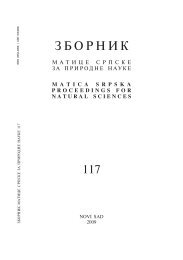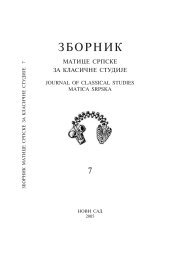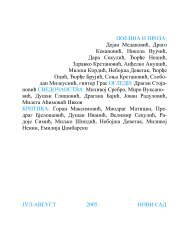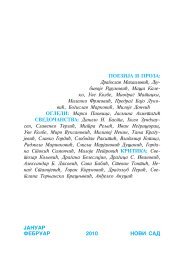Create successful ePaper yourself
Turn your PDF publications into a flip-book with our unique Google optimized e-Paper software.
All of this lets us better read details elsewhere. In a memorable<br />
sequence of Iliad 3, Helen sees through Aphrodite's disguise as an<br />
old wool-working woman (3.386—388), which in itself may mock<br />
Athena (whose name her darling Paris later will take in vain, 439).<br />
First Helen feels something in her uymÃj, then notices, in order, the<br />
goddess' “very beautiful neck, and desirable breasts, and glistening<br />
eyes" (Ómmata marmaåronta, 397). In the major Hymn Aphrodite<br />
also disguised herself, in that case as a bejeweled Phrygian princess,<br />
so that Anchises might not be stunned if he perceived her in (his)<br />
eyes m0 min tarb0seien ñn Ícualmoìsi no0saj, 83); and later,<br />
just before they go to bed together, she turns aside and casts her<br />
beautiful eyes down (metastrecueìsa kat' Ómmata kal2 balo‡sa,<br />
156).<br />
Returning to No. 6 we recall its mention of the seductive dance<br />
(xorÁj ímeroeåj) of the goddess and her companion Charites (ll.<br />
13—14). We may consequently note a likely irony in the scandalous<br />
myth of her adultery and its exposure in Odyssey 8. The bard<br />
Demodocus' account accompanies a kind of ballet (as we infer if<br />
we connect the dancing of 258—265 with the reported song and the<br />
duet dance with a ball that follows at 370—379). The principal narrative<br />
song-and-dance concludes with a scene reprising Aphrodite<br />
and those companion “Graces". After the divine adulteress' speedy<br />
retreat to the friendly confines of Paphos her charming sisters clean<br />
her up and give her fresh clothing, doing the best they can to efface<br />
her sensational embarrassment (362—366).<br />
Dances in fact are quite common in the Hymns. We find them<br />
not only where we would expect them, in ones to musical Apollo<br />
(No. 3, at l. 149 and probably 158—164) and his equally talented<br />
twin Artemis (No. 27, at ll. 16—20), and to Dionysus (No. 26, ll.<br />
9—10), but also where noisy rites honor the mother gods (Nos. 14,<br />
ll. 3—5, and 30, ll. 13—16). Pan, too, leads dances of high country<br />
nymphs (No. 19, ll. 19—31).<br />
ATHENA (Hymns 11 and 28; also 20 to Hephaestus)<br />
In Hymn No. 11, the first of the two to her, Pallas Athena matter-of-factly<br />
shares jurisdiction over warfare with Ares, whom in the<br />
Iliad she treats with relentless spite, unforgettably so in Books 5<br />
(755—853, and 21 391—415). Addionally, however, she protects (a<br />
gnomic aorist) an armed people going out (to battle) and coming<br />
home (ñrrÿsato laÁn øÃntÀ te nisÃmenÃn te, 4). Homecoming is<br />
thus part of her province, not of her violent brother's, who is in fact<br />
58

















